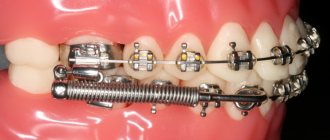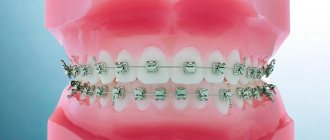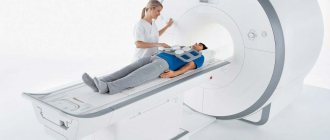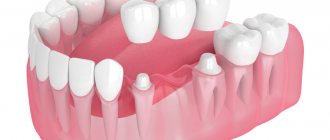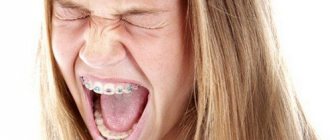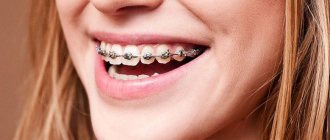To correct an abnormal bite, you can put braces on your teeth. Such orthodontic systems affect bone tissue, muscles and ligaments, and help slowly move teeth into the correct position. Many people are interested in the question: is it possible to put braces on one jaw? You will find the answer in this article.
In this article
- What are braces?
- Are braces placed on one jaw?
- Main indications for partial correction
- Orthodontic correction up to 12 years
- Braces for the lower jaw only for mild crowding
- Treatment for crowded upper anterior incisors
- Closing the gap between the front incisors
- Partial bracket system for preparation for prosthetics
- Absence of chewing teeth on the opposite jaw
- Should I install braces on one jaw or not?
What are braces?
A brace system is an orthodontic device that is installed on the teeth and helps them move in the desired direction. Structurally, this device consists of small plates (directly braces), which are glued to the dental crown at pre-calculated points, and a metal arch. This arc has shape memory and is an active element of the system. Fixed on the plates, it tries to regain its even position and thereby puts pressure on the teeth. As a result, their slow, gradual movement in the bone tissue occurs. Orthodontic treatment not only helps to correct the curvature of individual teeth in a row, it allows you to change the shape and position of the jaw, and restore facial symmetry.
It is preferable to begin orthodontic correction in childhood. But modern medical capabilities make it possible to carry it out even in adulthood and old age.
Most often, an orthodontic device is placed on two jaws at once. The dentist calculates in advance in which direction a particular tooth should move, how much it is necessary to expand the jaw or spread the dentition. Double-jaw treatment is comprehensive and allows you to solve global problems in occlusion correction. It usually takes from several months to several years.
Types of orthodontic appliances, design and materials
The design consists of the following elements - ligature, metal arches and elastic, braces made of metal or other materials. The device is used to transfer pressure to the surface of the row. This causes a restructuring of growth to give the row a normal position. The exerted force affects the movement of units in a row, allows you to correct it and eliminate growth pathologies.
The following types of constructions are used for correction:
- Vestibular orthopedic devices are attached from the outside. They are visible when worn, but provide high results. The design does not have a negative effect on the enamel if the Patient follows the care recommendations.
- Lingual systems are installed from inside the row. They are not noticeable when talking, but the cost of treatment will be higher due to more complex installation. In addition, an adjustment period is required, since at first the device may interfere.
The following materials are used for the manufacture of braces:
- metal, characterized by affordable cost, durability, reduced treatment time;
- ceramic, inconspicuous in appearance, durable, but susceptible to staining with food pigments;
- silicone based on special plastic, these are transparent structures that are distinguished by high aesthetics, but are indicated for correcting minor pathologies and slight curvature;
- sapphire transparent systems with high aesthetics, almost invisible on the enamel surface;
- combined, for example, sapphire braces are used for the upper row, and ceramic or metal-based for the lower row.
Installation Features
Fixation order:
- initial examination;
- Carrying out diagnostics, identifying problems, calculating treatment regimens;
- choice of design type;
- installation of orthodontic braces (takes about 1-1.5 hours);
- regular visits to the doctor to adjust the design;
- removal of the device;
- evaluation of the result and installation of a special structure to consolidate the result.
Price
We offer competitive rates for treatment and a free initial examination. The total cost of jaw braces depends on the following factors:
- condition of the oral cavity, the presence of diseases subject to preliminary treatment;
- performing office cleaning of plaque and stone deposits;
- prescribed diagnostic measures, consultations with related specialists;
- materials, type of construction, manufacturer;
- installation, activation of the device (calculated for each jaw separately);
- regular visits to tighten the arch and replace individual elements;
- the use of special devices after correction with braces.
About Us
Magenta Dental Clinic is a modern dental clinic offering services such as eliminating dental pathologies and restoring a beautiful, sparkling smile without pain and in the shortest possible time. Patients are provided with:
- modern methods of therapy;
- use of certified materials and equipment;
- full range of services, including diagnostics;
- control of treatment, guarantee of results;
- attentive attitude towards everyone, creation of comfortable conditions;
- affordable cost of jaw braces;
- free initial consultation with clinic doctors.
To make an appointment, leave a request on the website, indicating the coordinates for feedback. Call us at +7 (812) 242-91-90. You can also send a request for an appointment at a convenient time by email and consult with our doctors.
Are braces placed on one jaw?
Installing a brace system is one of the most common and effective methods for correcting an abnormal bite, improper closure of the teeth of the upper and lower jaw. Crooked teeth and abnormal jaw position not only spoil a person’s appearance, but also affect his health. Therefore, correcting the bite is important and necessary. But installing braces confuses many people.
Some are concerned about aesthetics, others are concerned about possible inconveniences when wearing the system, others simply want to save on orthodontic correction. And then the patient turns to the doctor with the following question: is it possible to install braces only on the upper jaw or only on the lower jaw.
As a rule, a person knows in advance which teeth he wants to change. And if they are located only on one jaw, then he expects that he will have a partial braces installed, only in the area of the curvature.
The doctor must make such a decision. It may seem to the patient that he has a problem only with the lower jaw, but the dentist sees during the examination that partial correction will not give an effective result. In this case, the orthodontist will insist on a complete correction. If you need a stable result of orthodontic treatment, we recommend listening to the professional opinion of an orthodontist.
Adaptation after installation of braces
The first days after installing braces are the most difficult. May have problems.
- Teeth hurt after installing braces.
- The mucous membrane is irritated.
- Diction has worsened.
- Difficulty chewing food.
- Braces interfere with the tongue.
All of the above is a natural reaction of the body to foreign objects. Teeth begin to move in the right direction immediately after treatment begins. It's painful, you'll have to be patient for a while. After installing braces, how much your teeth hurt is the most common question for an orthodontist. If he calculated everything correctly, after a few days the discomfort will decrease. If you can't stand it, take a painkiller. Continuous unbearable pain is a reason for an immediate visit to the doctor.
Pain after installing braces can be caused by irritation of the mucous membrane, in this case orthodontic wax will help. If there is strong pressure from the staples on soft tissue, rinse your mouth with a solution of 1 teaspoon of regular salt per glass of warm water. It is better to treat wounds in the oral cavity with disinfectants.
Gradually, the teeth will change their incorrect position, and the orthodontist will change the metal arch. After this, pain may appear again for a few days, but not as severe as on the first day after installing braces.
Main indications for partial correction
In some cases, it is indeed possible to place braces on one jaw, and this approach will be effective. As a rule, these are situations where the teeth are only crooked at the top or bottom, but the bite is not broken and there is no facial asymmetry. Partial correction may be recommended for the following indications:
- one or two teeth are positioned incorrectly;
- slight crowding of teeth (lack of space - up to 3 mm);
- a gap between the front incisors in the absence of pathological closure of premolars and molars;
- correction of the position of teeth before installing dentures;
- the need to avoid sagging of the upper teeth when their antagonists (opposite units) in the lower jaw are absent.
Diagnostics will show how effective braces will be only on the upper jaw or, conversely, on the lower jaw. It should include a visual examination, x-rays, assessment of the condition of bone tissue and dental roots.
Let's consider cases when it is justified to place braces separately on the upper jaw and separately on the lower jaw.
Orthodontic aligners as an alternative to braces: when can they be used and how much does installation cost?
If the diagnosis does not reveal significant malocclusions, you can refuse braces and straighten your teeth with aligners. Aligners, unlike braces, are removable designs - you can easily remove and put on the aligners at home, as needed. Mouthguards are made from polymer and completely transparent material, and therefore they will be invisible on the teeth.
Mouthguards for bite correction can be either standard or individual, and it is the latter design option that is recognized by orthodontists as the most effective. Individual mouth guards are made using an impression of the patient’s teeth and using three-dimensional modeling technology, so they will be comfortable for everyday wear and will help correct the bite faster (compared to standard factory mouth guards).
To correct your bite, you will need not just one mouth guard, but a whole set of orthodontic structures that are made individually for each patient. The price of such a set of mouth guards in our Firadent dentistry will be from 150,000 rubles
.
Using aligners to correct your bite does not mean that you will have to do everything yourself, and visits to the orthodontist for routine examinations are not necessary. It is necessary to visit a specialist during the course of correction - it is the doctor who will tell you when it is time to replace the aligners with the next model from the kit. Scheduled follow-up visits are not included in the cost of installing aligners and may increase the cost of treatment.
As you can see, the cost of installing mouth guards is not cheaper than the price of treatment with braces. You also need to take into account the fact that correction with mouth guards will require discipline on your part: if you wear mouth guards on your teeth less than expected and constantly remove them, you can’t count on a positive effect in correcting your bite.
Orthodontic correction up to 12 years
Braces are primarily used for children starting in their teens. This is due to the fact that by the age of 11-12 years the formation of the jaws is completed, and the primary bite is replaced by a permanent one. But often, an orthodontist discovers bite problems in a child at an earlier age. Installing partial braces helps solve some of them, as well as prepare teeth for further correction in adolescence.
The doctor can place an orthodontic device on one jaw or individual teeth in order to:
- create space for the eruption of permanent teeth;
- expand one of the jaws;
- close the gap between the front incisors (the so-called diastema);
- correct the incorrect position of one or more teeth that are bothering the child;
- preserve the space left after early removal of baby teeth, which neighboring ones are trying to occupy.
Thus, braces can be placed on one jaw at the age of 9-10 years to solve a specific orthodontic problem. In this case, in adolescence, further, already double-jaw, treatment will be required.
At what age should you start straightening your teeth with braces?
We recommend starting treatment at the age of 13—by this time, most adolescents have already formed their dental system. There is an opinion that it may be too late for adults to get dental braces. In fact, straightening teeth with braces for adults is possible at any age. The restriction applies only to cases where the patient has periodontal disease, teeth are loose or significantly damaged by caries.
Braces for the lower jaw only for mild crowding
Crowding is the position of teeth when they are too close to each other. As a result, rotation, curvature, and “layering” of each other occur. If slight crowding is observed only on the lower front incisors, while the upper front incisors are positioned evenly and the lateral ones close correctly, in this case, braces are sometimes placed only on the lower jaw. An important condition for this method is that there must be enough space to move horizontally so that the teeth can take the correct position. This treatment method is chosen in cases where the lack of space for alignment is less than 3 mm. With this method, separation of the front incisors is almost always performed - that is, minor grinding of the contact surfaces, which allows you to free 0.25 mm from each surface and in total create those missing 1-3 mm for alignment in the dentition.
Treatment for crowded upper anterior incisors
Braces on the upper jaw only can be placed if crowding is observed on the upper front incisors. The conditions are the same - the space deficit should be no more than 2-3 mm. In addition, treatment should not require expansion of the dentition. In this case, for orthodontic correction it is not necessary to involve the lower dentition.
If you provide space for uneven teeth by expanding the upper row, this will disrupt the closure. As a result, the teeth will “seek contact” with each other, the upper row will become narrow again, and in the long term the goal of orthodontic treatment will not be achieved. Therefore, if it is necessary to expand the upper row of teeth in order to correct crowding, a partial braces system cannot be used; a two-jaw apparatus will have to be installed. Braces can only be placed on the upper jaw if space for teeth is freed up using the separation method (their width is reduced by grinding the contact surfaces).
Differences between structures for the upper jaw and purpose
Using the device only for the upper jaw is recommended to eliminate problems with one or two teeth and in case wearing a mouth guard does not bring results. Externally, this is a classic type of system that can be installed outside or inside the row. Purpose:
- correction of minor malocclusions;
- the number of uneven teeth is small;
- no oral diseases.
For the maxilla, labial braces are commonly used. For those Patients for whom aesthetics are important, transparent braces are recommended. They are hardly noticeable when worn and do not cause discomfort. Materials such as artificial sapphire, ceramics or plastic are used for manufacturing.
Closing the gap between the front incisors
Braces can be placed on the lower jaw if there is a large gap (diastema) between the lower front incisors. In this case, several conditions must be met:
- the lateral teeth close together normally;
- there is an opportunity for a “joint to joint” closure of the front teeth of the upper and lower rows.
If these conditions are not met, it may be necessary to artificially increase the size of those teeth between which there is a gap. This is done using filling material. If the patient is not ready to fill healthy teeth in order to increase their size, then single-jaw treatment of diastema will not suit him, since the doctor will not be able to guarantee the stability of the result.
Partial bracket system for preparation for prosthetics
Sometimes braces are placed on only one jaw in preparation for prosthetics or in order to close empty spaces from extracted teeth. In the first case, braces help change the angle of the teeth to make room for an implant or bridge. In the second case, the brace system is used to move the posterior chewing tooth to the place of the previously removed one, thereby closing the empty gap and avoiding prosthetics. It is important to note that such treatment is usually complex and lengthy (tooth movement can take up to four years).
The orthodontist decides how appropriate it is to install a partial brace system for such indications in each specific case.
How are turnkey braces installed?
- Preparation. The surface of the teeth must be absolutely clean from bacterial plaque, so as not to provoke caries under braces. Therefore, each patient undergoes professional cleaning.
- Diagnostics. The doctor takes x-rays and impressions of the dentition, and using a computer program models the future smile and the movement of teeth in the right direction. Due to accurate calculation, the result is always predictable.
- Manufacturing. We scan the impressions with a CEREC scanner, obtaining an accurate 3D model of the patient's jaw (using a scanner increases production speed). Then we transfer it to a dental laboratory, where all elements of the system are manufactured within a few days. You will have to wait a little longer for lingual braces, since they are manufactured exclusively in the USA in the laboratories of the company Dentsply Sirona.
- Installation. The doctor treats the surface of the teeth at the attachment point and the inner surface of the braces with a safe adhesive that does not harm the enamel. Each bracket is installed with pinpoint precision, then secured with an archwire.
- Treatment. Once every 2-4 weeks (depending on the system), you see our orthodontist - he adjusts the tension of the arch and evaluates the results. All treatment takes 1-1.5 years.
Should I install braces on one jaw or not?
If the patient is concerned about the question of whether braces are placed on the lower jaw, then the answer will be positive. An orthodontic device can be installed not only on the lower or upper jaw, but also on individual teeth or areas of the dentition. But the main question is whether such treatment would be advisable. As a rule, installing a brace system on one jaw solves exclusively local dental problems. This process is more difficult to control and provides fewer treatment options. If contraindications are not provided, even a successful result will be short-lived, and the teeth will return to their previous position.
Thus, a dentist planning single-jaw orthodontic treatment must carefully assess the risks, take into account the many factors that will influence tooth movement and predict in advance the effectiveness and stability of the result.
If the doctor sees that solving the problem with a partial braces system will be problematic, he will recommend double-jaw treatment to the patient. Its advantages are that teeth can move in different planes without negative effects such as disruption of contacts between the upper and lower ones. Plus, such treatment is easier to predict and control, and it gives a more sustainable result.
Caring for braces after installation
Caring for braces after installation is more difficult than caring for teeth without them. There are more hard-to-reach places in the mouth to clean, and plaque forms faster. It is necessary to responsibly follow all the doctor’s recommendations so that later, after straightening, you do not have to put fillings on all your teeth. You will need an orthodontic brush, brush, dental floss and irrigator.
How to care for braces after installation?
- Teeth with braces must be brushed 3–4 times a day, slowly and thoroughly, ideally for 10–15 minutes. It is recommended to use a special orthodontic brush: you can recognize it by the inscription Orthodontic or Ortho. You will also need a brush to help clean your teeth around the braces. Dental floss can handle even the smallest food debris. An irrigator - a device that can clean the most inaccessible places - completes the care.
- Sticky food is a no-no as it can get stuck under your braces. It is better to postpone sweets, especially toffees, until after treatment, as well as foods and drinks high in sugar and acids.
- Sapphire, ceramic and plastic braces require an expanded list of limited products. Drinks containing high amounts of dyes—tea, coffee, soda, and some juices—can affect the color of your orthodontic system.
- In the first days after installing braces, it is not recommended to eat solid food. As for small children, everything should be pureed and liquid. This even applies to fruits. Anything that needs to be chewed is excluded. You can use meat, but be careful not to get stuck in the fibers. It is better to choose tender varieties and cut into small pieces.
If it is not possible to brush your teeth after eating, you should at least rinse your mouth. Even if you care for your braces according to all the rules, periodically undergo professional cleaning and rinse your mouth with a fluoride solution.
